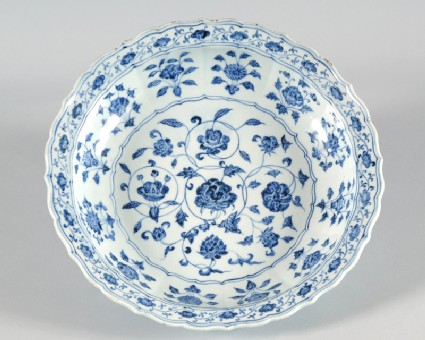The Barlow Collection
A select catalogue of the Barlow collection of Chinese Ceramics, Bronzes and Jades by the University of Sussex (published Sussex, 2006).

Publications online: 456 objects
Blue-and-white dish with floral decoration
- on display
- loan
-
Literature notes
The dish has deep rounded sides and an everted rim, both shaped in twelve bracket foliations, the centre of matching barbed outline, the circular foot of V-shaped section. The dish is painted in a bright purplish cobalt-blue with a composite flower scroll in the centre with a peony surrounded by hibiscus, lotus, camellia and another flower, each with matching leaves. Twelve flower sprays are depicted each around the inner and outer sides, showing morning glory, lotus, peony, chrysanthemum, pomegranate, and hibiscus, each repeated twice. A lingzhi scroll decorates the rim inside, while the outer rim is plain except for blue outlines. The footring and base are left unglazed and have fired an uneven bright orange colour. -
Details
- Associated place
-
Asia › China › Jiangxi province › Jingdezhen › Jingdezhen kilns (place of creation)
- Date
-
1403 - 1425
Ming Dynasty (1368 - 1644)
- Material and technique
- porcelain, thrown, with underglaze painting in cobalt-blue
- Dimensions
-
7.1 cm (height)
38 cm (diameter)
- Material index
- Technique index
- Object type index
- No. of items
- 1
- Credit line
- Lent by the Sir Alan Barlow Collection Trust.
- Accession no.
- LI1301.144
-
Further reading
University of Sussex, and Arts and Humanities Research Council, The Barlow Collection, supervised by Regina Krahl, Maurice Howard, and Aiden Leeves (Sussex: University of Sussex, 2006), no. C119
Glossary (2)
porcelain, underglaze painting
-
porcelain
Ceramic material composed of kaolin, quartz, and feldspar which is fired to a temperature of c.1350-1400⁰c. The resulting ceramic is vitreous, translucent, and white in colour.
-
underglaze painting
Painting applied to ceramic material before a transparent, or monochrome or coloured glaze for Islamic objects, is applied. The technique was initially developed in China.
Location
Objects are sometimes moved to a different location. Our object location data is usually updated on a monthly basis. Contact the Jameel Study Centre if you are planning to visit the museum to see a particular object on display, or would like to arrange an appointment to see an object in our reserve collections.
Galleries
Publications online
-

The Barlow Collection
The dish has deep rounded sides and an everted rim, both shaped in twelve bracket foliations, the centre of matching barbed outline, the circular foot of V-shaped section. The dish is painted in a bright purplish cobalt-blue with a composite flower scroll in the centre with a peony surrounded by hibiscus, lotus, camellia and another flower, each with matching leaves. Twelve flower sprays are depicted each around the inner and outer sides, showing morning glory, lotus, peony, chrysanthemum, pomegranate, and hibiscus, each repeated twice. A lingzhi scroll decorates the rim inside, while the outer rim is plain except for blue outlines. The footring and base are left unglazed and have fired an uneven bright orange colour.
Notice
Object information may not accurately reflect the actual contents of the original publication, since our online objects contain current information held in our collections database. Click on 'buy this publication' to purchase printed versions of our online publications, where available, or contact the Jameel Study Centre to arrange access to books on our collections that are now out of print.
© 2013 University of Oxford - Ashmolean Museum







